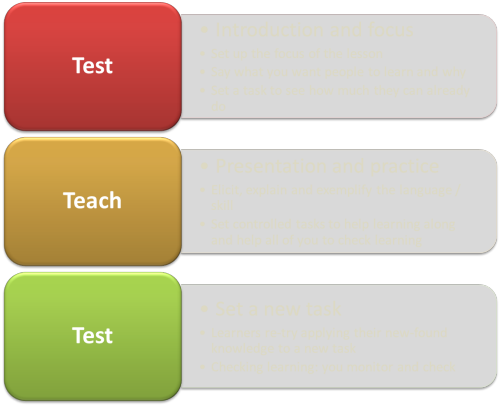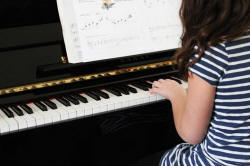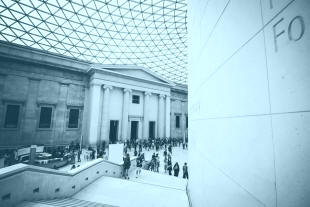TKT Module 1: Background to language teaching
Presentation techniques and introductory activities

Introducing the topic and aims and presenting the targets are critical phases of any lesson but they aren't the same. Of course.
 |
Key concepts in this guideBy the end of this guide, you should be able to understand and use these key concepts:
|
Look out for these words like this
in the text.
There will be tests at the end of the guide for you to check that
you understand the ideas.
 |
Lesson structures |
Before we can focus easily on presentation techniques, we need look
briefly at the structures of lessons to see where they can come.
There are many possible ways to structure a lesson in English
language systems or skills. Here we look at two.
As our examples, we are going to take a reading skills lesson concerned
with skimming and scanning skills and a grammar (systems) lesson focused
on using the present perfect tense to talk about experiences which have
changed your life.
We are assuming that the learners know little
or nothing about either.
 |
The nuts and bolts of lessons |
There are 5 essential elements of most lessons. We are only
concerned with two of them here but this will help you set things in
context. The next two guides in Module 1 of this TKT course
will focus on the other stages.
This is not a list with number 1 at the beginning and number 5 at
the end because where the stages come will depend on the structure
of the lesson and its targets.
For example, if the lesson targets are completely new to the
learners, we may make presentation an early stage. If,
however, the lesson is revision, then checking and assessment of
what has been learned may come first and practice may come before
more presentation.

Whatever the stage of the lesson, the target stays central (or it should).
 |
Two possible structuresThese are just two of the many possible ways of structuring lessons. There are others. |
Approach 1: presentation, practice, production (PPP) |
Approach 2: test, teach, test (TTT) |
| This is probably the most popular form of lesson structure and it
is the one on which most course-book writers seem to base their
material. Can you fill in (on paper or in your head) where the 5 must-have stages come? Click on the image to check. |
In this approach, you first find out what the learners can and can't
do by setting them a task. Then, having identified the issues,
you teach the target language or skill and then test again with a
different task. Again, what goes in the blank boxes? Click on the graphic to check. |
 |
 |
 |
Framing and transitionsIn both the examples above, the introduction, rather obviously,
comes at the beginning of the lesson. That's what the verb
introduce means. |
Here are some examples of framing statements which allow the transitions from stage to stage to happen and keep learners on track as well as giving them a sense of structure and progression.
| Ending a lesson phase | Summing up and evaluating | Re-focusing and moving on |
| Loud hand clap / Bell ring / Other noise | That was
excellent. You pronunciation needs work but you have the form right. |
Now we need to move on to ... |
| Right! Stop now. | How do you
think you did? John? |
Let's try something a little different now. |
| OK, everyone. Put your pens down and listen, please. | What have
you learned from that? Tell me two things you learned, Josephine. |
Now we need to look at some more examples. |
| Great. That's enough now. | You all
had some really good ideas. I particularly like Mary's way of looking at the problem. Tell us Mary. |
OK. Now we have the main ideas in the text clear, let's look at some of the language. |
 |
Introduction techniques |
 |
Task 1:
The beginning of a lesson is not usually a transition, of
course, but it is the opportunity to
focus the learners. Here are some examples. When you have decided which ones would interest you, click here. |
- Today we are going to look again at the present perfect progressive.
- Please read this article.
- I'm so glad I became a teacher because I have had the chance to work with so many lovely people. Are you happy with your career? Think of one reason you are glad you chose it and tell the person next to you.
- Here's a short e-mail from my mother that I got last week. Please read it alone and then, when you are ready, talk to your partner and decide what her problem is. How do you think I replied?
- In today's lesson, we are going to talk about an ideal city.
- Look at these pictures on the projector, please. Talk to your partner and decide where they were taken.
- Do you like background music in bars and restaurants? Tell me what you think.
Number
1 is not likely to make most students gasp with pleasure, is it?
This focus is only on form with no indication of what the topic of
the lesson is and what the form is used for. The word 'again'
doesn't help, either!
Number 2 is also a poor idea. The learners have no idea what
the text is about or why they might want to read it.
Number 3 is much better. You have made it personal and also
neatly introduced the target form (the present perfect to talk about
now in relation to the past).
Number 4 is also good because the learners have a reason to read,
the email is real and personal and they have to engage with the
meaning to answer the question.
Number 5 is poor. Why should the learners want to do this?
Are they interested in such things? It might work if you have
a class of architects.
Number 6 is better because we all like images and small guessing
games to think what they represent. It's also a good way to
introduce the topic without having too much language to understand.
Number 7 is much too sudden. Most people's answers will be
something like "Err, well, I don't know really. Why do you
ask?" Think how you would respond if anyone said that to you.
A lesson can fail from the outset if the introduction is poor.
 |
Presentation techniques |
The presentation will include an analysis of the language or
skill and is also the time to set targets so the learners know where
they are going and what their goals are. In an ideal world,
the presentation will follow very naturally from the introduction
activity.
This is a key stage where you explain and exemplify the language
or skills point.
Presentation can happen in three main ways:
- teacher-led

- Teacher-led presentations are common, especially with
language systems lessons and especially if the target is new to
the learners.
For our example of teaching the present perfect, you might start with a personal anecdote about how 3 things that you have done have changed your life (learned a language, had a baby, become a teacher etc.). A few concept checking questions would follow that.
Then you'd present the form and its pronunciation and concept check the meaning again to make sure everyone has it right.
For the example of the skills focus, you could use examples of two real texts, one that you would skim to find what you want (a newspaper is an example) and one you would scan for data (a timetable, for instance).
Then you'd explain / elicit how you go about doing these two things. - materials-led

- Once people have a reason to read, watch or listen, we can
let the materials do the presenting providing we are sure that
the learners will be able to notice the language.
For example, a short video about two people discussing life experiences could be used to introduce the present perfect for this function if, once global understanding is achieved, the learners have a transcript of the conversation in which they can notice the language forms. - learner-led

- In a Test–Teach–Test lesson format, it is often the language and communication issues which arise from the first testing procedure which form the presentation of the lesson targets. Learners can identify for themselves where they are having trouble and what language / skills resources they need to do a better job.
 |
Self-test questions |
Before you go on, make sure you can answer these questions. If you can't, go back to the sections which give you trouble.
- What do PPP and TTT stand for?
- Why should transitions be clearly signalled?
If you are happy with your progress, go on.
 |
Tests and practice for TKT |
| Test 1 | A short matching task |
| Test 2 | A gap-fill test |
Return to the Module 1 index:
![]()
or go on to the next
guide which is to
practice activities and tasks for language and language skills
development.
